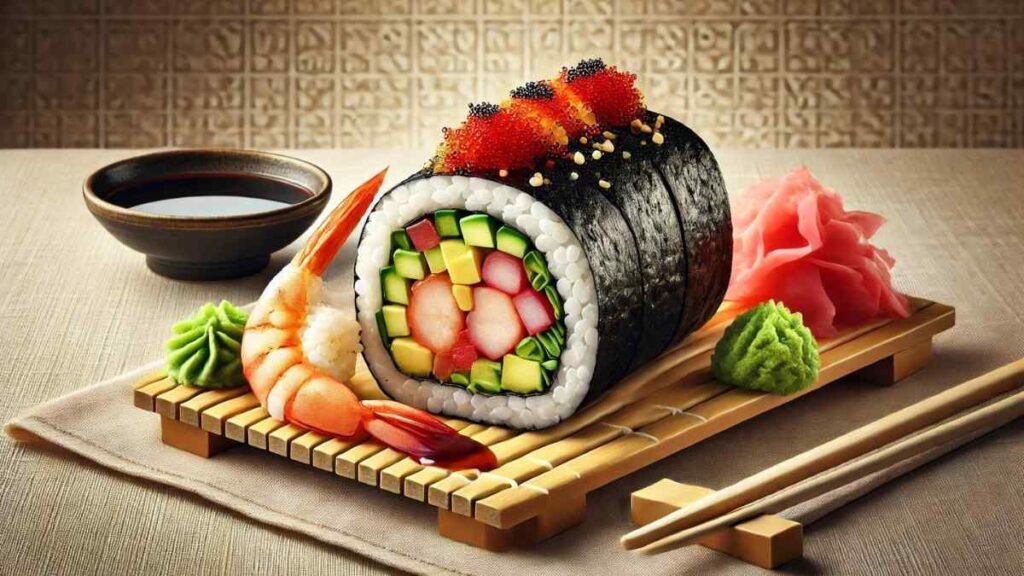The Boston Roll is a popular sushi roll known for its fresh and vibrant ingredients, including cooked shrimp, avocado, and cucumber, all wrapped in a layer of nori and sushi rice. Topped with a slice of red tuna or tobiko, the Boston Roll offers a delightful combination of textures and flavors that appeal to both sushi newcomers and enthusiasts alike. Its mild taste and visually appealing presentation have made it a favorite in sushi restaurants across the United States.
Introduction
Sushi has taken the world by storm, and among the many variations that have captivated taste buds globally, the Boston Roll stands out for its unique flavor profile and cultural significance. This article delves into the origins, ingredients, preparation methods, and the influence of the Boston Roll on culinary trends. Whether you’re a sushi aficionado or a curious newcomer, this comprehensive guide will provide everything you need to know about the Boston Roll.
What is a Boston Roll?
The Boston Roll is a type of maki sushi, which is a rolled sushi variety that typically includes ingredients like seafood, vegetables, and rice, wrapped in seaweed (nori). Unlike some traditional sushi rolls, which may use raw fish, the Boston Roll features cooked shrimp, making it a great option for those who are not keen on raw seafood.
Key Ingredients
- Cooked Shrimp: The primary protein in a Boston Roll, providing a tender and slightly sweet flavor.
- Avocado: Adds a creamy texture and rich taste.
- Cucumber: Offers a refreshing crunch that balances the richness of the avocado and shrimp.
- Nori (Seaweed): The traditional wrap for the sushi roll, giving it a savory and slightly briny taste.
- Sushi Rice: Sticky and slightly vinegary rice that holds the roll together.
How to Make a Boston Roll at Home
Creating a Boston Roll at home is simpler than you might think. With a few fresh ingredients and a bit of practice, you can enjoy this delicious sushi roll in the comfort of your own kitchen.
Step-by-Step Instructions
- Prepare the Sushi Rice:
- Rinse 2 cups of sushi rice under cold water until the water runs clear.
- Cook the rice according to the package instructions.
- Once cooked, mix the rice with 1/4 cup of rice vinegar, 1 tablespoon of sugar, and 1 teaspoon of salt. Let it cool.
- Cook the Shrimp:
- Boil water in a pot and add a pinch of salt.
- Cook the shrimp until they turn pink, about 3-4 minutes.
- Drain and let the shrimp cool before slicing them in half lengthwise.
- Assemble the Ingredients:
- Lay a sheet of nori on a bamboo sushi mat, shiny side down.
- Spread a thin layer of sushi rice over the nori, leaving a small margin at the top.
- Place the sliced shrimp, avocado, and cucumber along the center of the rice.
- Roll the Sushi:
- Use the bamboo mat to carefully roll the sushi, starting from the bottom and rolling tightly.
- Apply gentle pressure to shape the roll.
- Once rolled, slice the sushi into bite-sized pieces using a sharp knife.
- Garnish and Serve:
- Top each piece with a slice of red tuna or a sprinkle of tobiko (flying fish roe) for added flavor and color.
- Serve with soy sauce, pickled ginger, and wasabi on the side.
The Cultural Significance of the Boston Roll
Beyond its culinary appeal, the Boston Roll has made its mark in pop culture, particularly in the United States. Its introduction to American sushi restaurants was part of a broader trend to adapt traditional Japanese cuisine to suit Western palates. The use of cooked shrimp instead of raw fish made sushi more accessible to a wider audience, contributing to the dish’s popularity.
Boston Roll Sushi vs. Traditional Sushi Rolls
While the Boston Roll shares similarities with other sushi rolls, such as the California Roll, there are distinct differences that set it apart. Traditional sushi rolls often feature raw fish like tuna or salmon, whereas the Boston Roll uses cooked shrimp. This difference in preparation appeals to those who may be hesitant to try raw seafood.
The Impact of Boston Rock and Roll Bands on Sushi Culture
Interestingly, the name “Boston Roll” might also draw inspiration from the vibrant music scene of Boston, particularly its famous rock and roll bands. While this connection is more anecdotal, it’s fascinating to consider how cultural elements, like music, can influence food trends. The fusion of these cultural aspects adds an extra layer of intrigue to the Boston Roll, making it not just a dish, but a symbol of cultural convergence.
Nutritional Information
For those mindful of their diet, the Boston Roll offers a relatively healthy option. Here’s a breakdown of its nutritional content per serving (approximately 6 pieces):
- Calories: 250
- Protein: 12g
- Carbohydrates: 35g
- Fat: 7g
- Fiber: 3g
- Sodium: 450mg
This makes the Boston Roll a balanced choice for a light meal or snack.
Variations of the Boston Roll
The Boston Roll has inspired numerous variations, with chefs experimenting with different ingredients to create new flavors. Some popular variations include:
- Spicy Boston Roll: Adding spicy mayo or sriracha for a kick of heat.
- Boston Tempura Roll: Incorporating tempura-fried shrimp for a crispy texture.
- Vegetarian Boston Roll: Substituting shrimp with tofu or additional vegetables for a plant-based option.
Conclusion
The Boston Roll is more than just a sushi roll; it’s a culinary experience that combines the freshness of its ingredients with the rich cultural history of sushi. Whether you’re enjoying it at a high-end restaurant or making it at home, the Boston Roll offers a delightful taste of both tradition and innovation. Its accessibility, thanks to the use of cooked shrimp, and its cultural resonance make it a beloved choice for sushi lovers across the globe.
For More Visit, MirrorMagazine.co.uk


